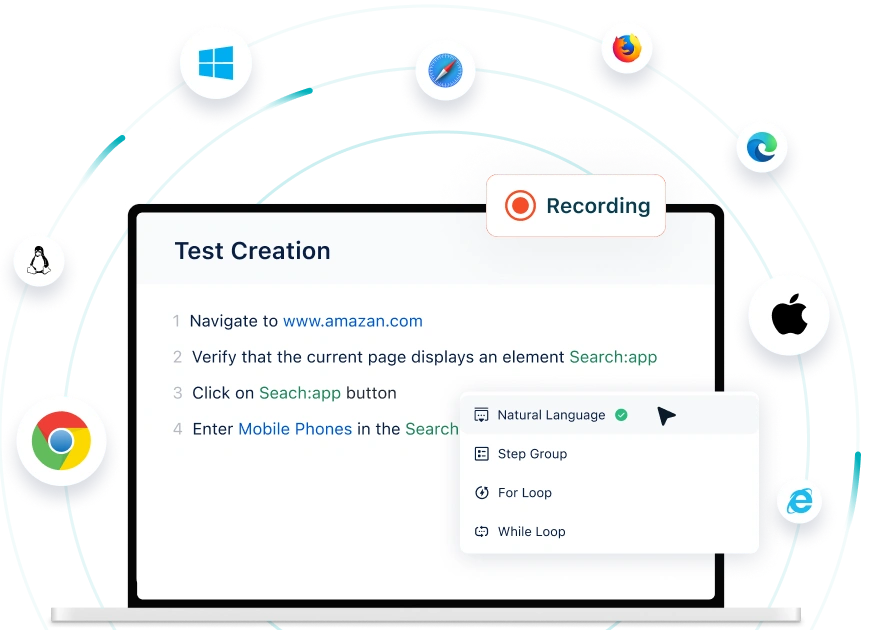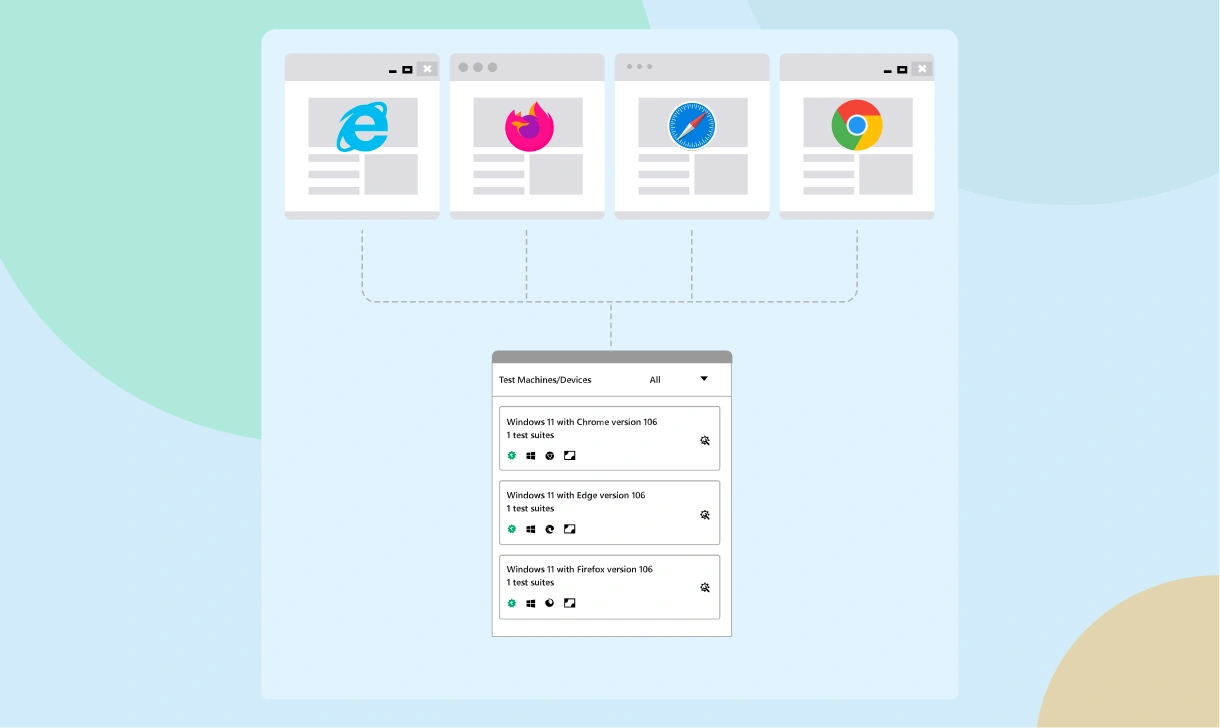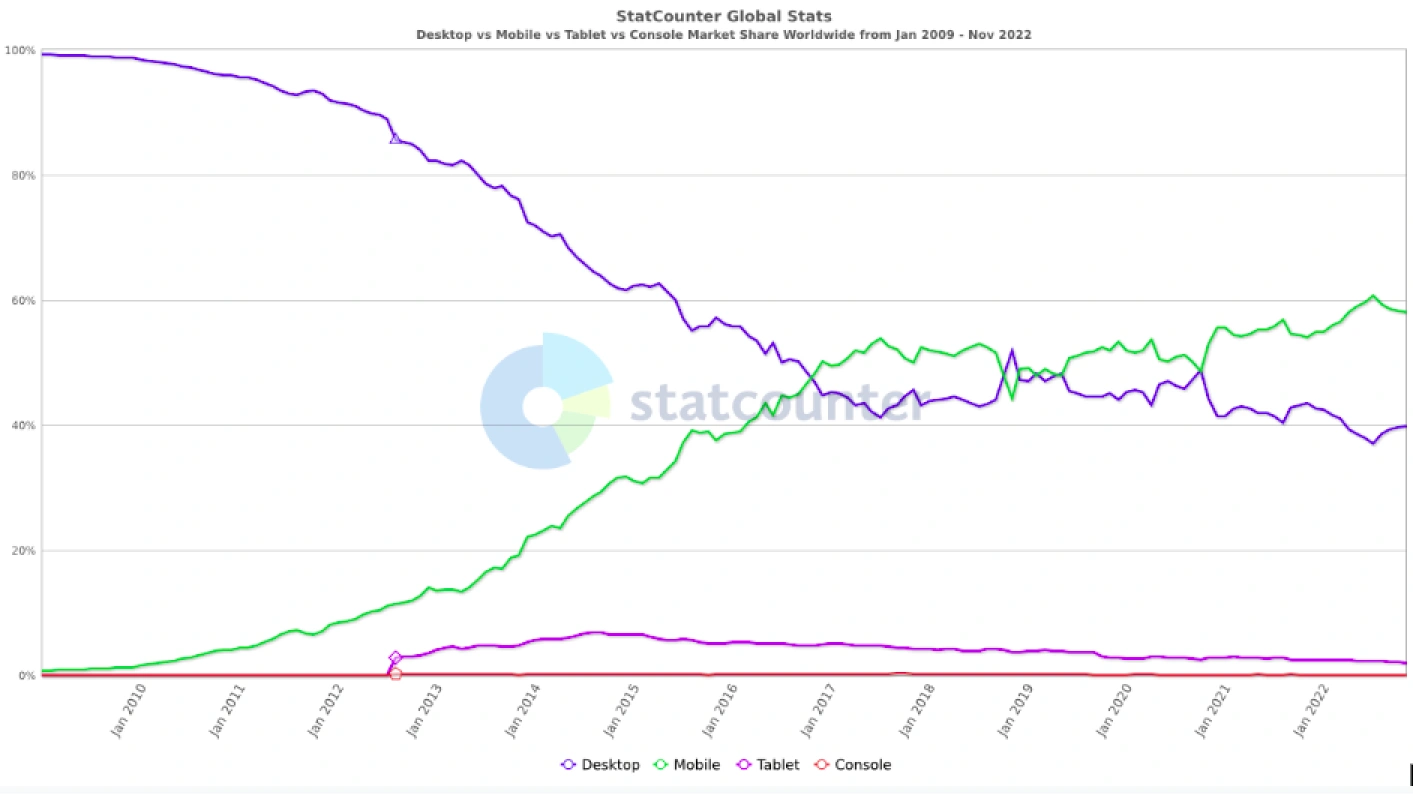Topics

Ultimate Guide
to Cross Browser Testing with GenAI
Automate Tests for web, mobile, API, and desktop apps in one unified platform
Test Across 3000+ Real Devices, Platforms, and Versions on the cloud, ensuring comprehensive coverage
Create Tests in Plain English using NLP-driven test creation for ease of use

Cross Browser Testing Guide: Everything You Need to Know for Browser Testing
Cross-browser testing is vital for any web application because you never know which browser your users will view your website on. You might create a great app that looks amazing on Chrome, but what if it doesn't work on Internet Explorer (which has been discontinued, sadly) or Safari? If a customer tries to use your app on one of those browsers and it doesn't work, they'll likely switch to a competitor's product. Cross-browser testing helps prevent that by ensuring that your app works correctly on all major browsers. This way, you can retain your customers and keep them happy.
Customers will buy what they see and will likely desert your website in seconds if even your cute mascot gif takes time to load. They'll probably reload the page, assuming the site has an issue, and leave to return later, or thinking that the site is broken and go to find an alternative in a wink. That's why ensuring your website cuts across all environments is crucial.
Even if the page is optimized at best for browsers like Google Chrome and Firefox to overpower the demand, people are operating their over-the-hill versions or various browsers. And their number crunching is intolerably high to be overlooked.
To put it in Darwin's words, “the survival of the fittest” will only ensure your website's success.
Crossbrowser testing ensures that you fall on the fittest side of the ecosystem.
With website browser testing, we ensure consistency across multiple browsers-
- The website's display on different browser and OS combinations.
- The website's functionality on different browser and OS combinations.
Who Performs Cross-Browser Testing?
In a nutshell, everyone who designs or develops for the Open Web can perform cross-browser testing.
You don’t need to be a coder to use interactive cross-browser testing tools - marketers and web designers can use them to test landing pages and fresh designs for cross-browser rendering and responsiveness.
QA teams use these tools to test scenarios on different browsers and ensure that the build meets browser compatibility criteria. UI teams can use them to determine how the website front-end performs on various devices and orientations.
The decision of what combination of platforms, browsers (their versions), OS, and devices is to be included in cross-browser testing is made by stakeholders (client, business analysts, and marketing specialists). Sometimes, the developers and testers may also have a say in this decision.
Traditionally, the testing part is taken care of by:
- Development team: The design or development team coding the web application may do some testing. They check the design and UI features like- images, font, alignment, etc., on different browsers and make quick changes accordingly.
- Quality Assurance (QA) team: The testing team is more responsible for cross-browser testing activities. They execute the same test cases on different platforms and browser combinations to ensure the functionality is fixed. They check the compatibility of the application across other browsers. In case of discrepancies, the QA team raises defects, and the development team makes the fixes.
Traditionally, these two team players work on testing and ensuring that the website is good to go in all aspects, including functionality, responsiveness, design, and accessibility.
But, the revolutionary, AI-based, end-to-end, Codeless tool, or let's stick with Testsigma, ensures that cross-browser testing can be performed by anyone with its simple English NLP's.


When should cross-browser testing be performed?
You might be doing cross-browser tests depending on your position and workflow:
During Development: Before publishing changes to production, developers in Continuous Integration pipelines test new features to ensure they are cross-browser compatible.
In Staging/Pre-Release: QA teams do this for each Release Candidate to ensure no browser compatibility issues in the most recent version of the website.
How To Perform Cross-Browser Testing?
Website browser testing, aka Cross-browser testing, is performed in two ways:
Manual Cross Browser Testing:
Teams can do cross-browser testing manually, noting changes in functionality on different web clients or manually executing test scripts on other clients. This type of website browser testing is best suited for small websites and applications, but still, the sheer amount of human interaction required to test every aspect as precise as nearly 100% is beyond one’s means.
To manually test a website, we must install several browsers and operating systems on various desktops and mobile devices. Then, we must manually perform the same test cases in each chosen environment. This takes time and is exhausting for testers. As a result, the entire testing duration is enormous. Furthermore, manual testing in a variety of situations is impractical. Therefore, cross-browser testing automation is required to complete testing activities quickly.
Automated Cross-Browser Testing with GenAI: Why You Need It
Manually testing a website across multiple browsers is like trying to find a needle in a haystack — every single element, page, and interaction needs to be tested on a range of browsers, OS, and devices. With the vast combination of environments available today, testing manually is impractical.
That’s where automated cross-browser testing powered by GenAI comes in. It’s essential for organizations that need consistent performance across all supported devices and browsers. GenAI-powered automation tools allow you to quickly and efficiently conduct cross-browser testing with complete accuracy.

Key Benefits of Automated Cross-Browser Testing with GenAI:
- Access to Thousands of Real Test Environments: Test across 3000+ real devices, platforms, and versions to ensure your app performs well everywhere.
- Real-Time Device Testing: Conduct testing on devices with varying resolutions, configurations, and browsers to mimic real-world usage.
- Support for Visual, Functional, and Regression Testing: Ensure your application works flawlessly from every angle.
- Parallel Test Execution: Run multiple test cases simultaneously to save time and speed up your testing process.
- CI/CD Integration: Seamlessly integrate automated cross-browser testing into your continuous delivery pipeline.
- Detailed Test Reports: Get clear insights with screenshots, logs, and even video recordings of test sessions for deeper analysis.
- Start automating your cross-browser testing now and experience faster feedback and higher-quality releases with Testsigma powered by GenAI.
Things to decide In Pre-testing for Cross browser testing
Choose critical scenarios:
It is wise to choose the essential scenarios to test first, and then we can test the rest. We can select the test cases depending on the business criticality of functionality and UI usage.
Choose the environments and compare:
The testing team is more responsible for cross-browser testing activities. They execute the same test cases on different platforms and browser combinations to ensure the functionality is fixed. They check the compatibility of the application across other browsers. In case of discrepancies, the QA team raises defects, and the development team makes the fixes.
Operating System:
We need to know our users will primarily use which operating systems from Windows, Android, iOS, macOS, etc.
Device:
We need to check on which platform our user will be accessing our application- desktop, mobile, tablet, smart TV, laptop, etc.
Cross Browser Testing Scenarios - Check and Build your Testcases for Devices

- Is this website or app compatible with tablets?
- Does this website work on mobile devices?
- Is this website responsive to the particular resolution?
- Is this website available on the Windows platform?
- Is this website accessible on Apple iOS?
- What are some of the various device platforms that the website supports?
Browser(mobile and desktop)
Deciding which browsers to use for cross-browser testing is crucial. We will pick the most preferred ones based on users who would use primarily using data and analytics.
Manually, we can only test an application on some possible browsers, OS, and platform combinations. But if we use a tool like Testsigma that allows us to test on and that too in parallel, we can complete the otherwise time taking work in a short period.

The scenarios you can check and build up your test cases for browsers:
- Is the website viewable in the browser?
- Are the elements visible (such as buttons, forms, and menus)?
- Are the elements on the page clickable?
- Is the page's content visible on all devices?
- Is a specific browser version required for the website?
- Is the webpage taking longer to load in the browser?
- A mobile browser should be included in your test. Each mobile platform uses a particular type of browser for testing, such as UCBrowser, Safari, Chrome, etc.
CSS Compatibility
CSS plays a significant role in cross-browser testing. This is what makes or destroys a mobile app or website. As a result, most of your testing will revolve around this area. You have a lot of tests to do to check your website's performance. Here are some possible exam scenario questions.
Here are few questions required to ensure the smooth ongoing of your browser:
- What is the CSS Version?
- What CSS Version does the browser support?
- What is the CSS rendering engine being used?
- Is CSS throwing an error?
- Does CSS minification affect rendering?
- Is there code in CSS for responsive layout?
- Can CSS make calls to external image sources?
- Can CSS make calls to external font sources?
- Is the size of the CSS affecting page speed?
- Does CSS rendering influence the loading of specific elements?
Network
We often need to pay more attention to points when assessing websites. Most websites will render differently if your connection speed is slow. They cause small-sized objects first, followed by larger-sized parts. And you can use those circumstances to construct test cases for your network testing.
Here are few questions required to ensure the smooth ongoing of your browser:
- Is the webpage partially loaded when using a sluggish connection?
- Does the website work on a slow connection?
- Is the website missing critical elements while rendering ultimately on an idle connection?
- Does the content delivery network (CDN) influence webpage rendering?
- Is ISP speed a factor in page rendering across browsers?
- Is the browser responsive to sluggish connections?
The tool you choose should be “the jack of all trades and better than master of one.” One such tool is Testsigma, an AI-enabled automation testing tool that takes care of parallel testing effortlessly.
Selecting emulators/ simulators and devices:
We should clearly understand what emulators, simulators, and real devices we would need for cross-browser testing. Accordingly, we can choose the tool.
Deciding the tools is necessary because-
- We require access to a wide range of environments for testing.
- Parallel execution of test cases which reduces the overall testing time.
- Execute the maximum number of required test cases, which is impossible in manual testing. Hence provides a broader coverage of test scenarios.
- Run the same test case multiple times after changing the environment. This results in the reusability of test cases.
Hence, we should choose the most suitable tool according to our requirements and budget. Cross Browser Compatibility Testing Checklist can help you pip out the flaws in your website and ensure it survives any environment.
How to start with Cross-Browser Testing:
A Comprehensive list
Handle the older and rarely used browsers:
Compatibility needs to be evaluated for older and less popular browsers that users have not updated and do not support JS or CSS features.
Although it may seem that no one uses IE now, some users still use older versions of IE. We need to test and handle this scenario, also. For these browsers, redirect the user or create a basic version of the application to run on these browsers.The site may not function on older browsers; hence it is wise for the development team to write a separate stylesheet for IE.
Test early:
Start the unit testing once one page is developed. This will help the development team in fixing the defects early. Once the application is ready proper functional and visual testing should be carried out.
Handle bugs that are not dependent on browsers:
Some bugs are not reliant on browsers(CSS-related); on every browser, they behave similarly. Therefore, it is optional to test them on every browser; this saves time.
Techniques to test such style-related bugs are-
- Resize the browser
- Test with CSS off
- Test with JavaScript off
- Test with CSS and JavaScript, both off
- Zoom in and out
Prioritize the browsers:
Check the usage of browsers by users and rate them based on risk:
- Low: They are the top 4-5 browsers used mainly by users and cause minimum risk to the application. E.g. Chrome, Firefox, Safari, etc.
- Medium: They are medium-risk browsers that are neither extensively used nor rarely used.
- High: They are the browsers that are rarely used and may cause greater risk because they are no longer maintained and upgraded.
Test the browsers-
- First, test the high-risk browsers by changing the resolution, screen size, etc.
- Then test the low-risk browsers by changing the resolution, screen size, and additionally on different devices.
- Finally, test a few of the medium-risk browsers.
Whatever bugs you encounter during these three steps, fix them. Now repeat these three steps until you do not find any more issues.
Future expansion:
The testing strategy should take care of the expansion that may follow after months. The increase in user base should be taken care of in the current testing. E.g., Mobile users are significantly increasing in the coming years, so this needs to be considered during everyday cross-browser testing activities.


Features Analyzed in a Web Browser Test
Compatibility testing is essential, but you may sometimes have the time for it. To do it well, product teams should limit their testing and create a test specification document that outlines the essential features to test, the browsers/versions/platforms to test on, the test scenarios, schedules, and the budget. This will help ensure that all the necessary bases are covered.

General Browser Compatibility:
The technical and critical features for the website to work correctly will be checked i.e, CSS, DOCTYPE, SSL CSS, HTML, and XHTML
Functionality:
Verifies that the website works on most browser-OS combinations. For example, you could test to ensure that:
- All forms fields work correctly, including input validation.
- This website correctly stores and retrieves first-party cookies (and features like personalization that depend on them).
- Touch input is smooth and responsive for mobiles and tablets.
Design:
This guarantees that the website’s appearance (fonts, pictures, and layout) fits the Design team’s criteria.
Accessibility:
Accounts for Web Content Accessibility Guidelines (WCAG) compliance to allow differently-abled users to visit the website.
Responsiveness:
This ensures that the design is fluid and adapts to different screen sizes and orientations.
The browser compatibility testing checklist can be used to guarantee that no crucial aspects are overlooked, which could lead to difficulties later on. By using this checklist, you can ensure that your website will function properly for everyone.
Choosing the right Browsers to Test
It is hard to design for and test every browser-OS combination due to the variety of browsers, devices, and operating systems accessible.

A more feasible goal is to focus your testing efforts on boosting your website’s reach inside your target market. To do so, you must secure the following:
Research the user volume on different browsers through analytics or market research:
The idea is to determine which browser-OS pairing is most popular among your target demographic. To do this, select the 10-20 most popular or frequently used browsers, and choose two of the most popular platforms, such as iOS and Android. This will help broaden your reach in any particular market. B2C (business-to-consumer) websites frequently optimize for this.
Examine your website’s traffic statistics acquired by analytics tools (such as Google Analytics or GA4) and categorize them by device/browser based on the findings.
Cross Browser Testing Checklist
Pre-conditions for Cross Browser testing to ensure the below conditions are met before starting cross-browser testing:
Define the scope of testing-How much testing will be carried out, what is the deadline for testing, and how much functionality will be covered?
Create a cross-browser testing strategy- Which browsers(and their versions) will be used, and which OS and devices will be used? Will all combinations be tested?
Choose the right tool- Choose the perfect automation cross-browser testing toolfrom the available ones. While selecting, we may ask questions like-
- Does it perform functional and visual testing?
- How many browsers and operating systems do the automation tools support?
- Does it integrate with third-party tools?
- Does it support parallel testing?
- Does the tool provide good technical support?
- Does its pricing meet the budget?
Check here - Cross Browser Testing Challenges
Are Your Devices Ready For Testing?
Have mobile devices, simulators/emulators, or cloud-based testing tools ready before testing.
After the prerequisites are met, we can follow the below checklist across different browsers:
- Validate SSL, CSS, and HTML
- Alignment and spacing of web elements(checkboxes, buttons, dropdowns, text fields, etc.)
- Validate the page layout in different resolution devices
- Design, effects, and styles are consistent on all pages
- Navigation of pages is proper
- URL as are correctly redirected
- Search and help are properly working
- Scroll- (vertical and horizontal) is working
- Fonts visibility(color and size)
- Text alignment
- Tool tips and mouse hovering are fine
- Media (audio, videos, and images) are properly displayed and work
- Forms work fine- save, submit, cancel, import, export, etc.
- File (upload and download)
- API connectivity is uninterrupted
- Sessions and cookies prompt is displayed.
- The date format is consistent
- Verify zoom-in and zoom-out functionality
- Verify the pop-ups are working consistently
- Animation is working
Check here - Emulate Safari


Cloud-Based Cross-Browser Testing: End-to-End Solution
For cross-browser testing, we require a combination of different OS, browsers, and devices which can be enormous in number. Manually testing these combinations is impossible, and a locally set test tool may not provide the required scalability and flexibility. Maintenance and setup of the infrastructure will also need time and resources. The solution for this is to use cloud-based cross-browser testing.
The features of cloud-based cross-browser testing are
- They provide environments that are ready to use. We just need to select the environment and run test cases.
- Immediate test runs are possible because the required infrastructure is already available.
- We can pay for an environment and use it immediately.
- They can be accessed from anywhere, so helpful for remote teams.
The benefits are:
- No setup is required for infrastructure
- Availability of real devices
- Online 24*7 access
- Scalable
- Parallel testing
- Accessible from anywhere
- Stability of the testing environment
Summary:
So, how do you ensure end-users get a great experience from all their browsers? You test!
Tests need not be monotonous, time-consuming, and definitely not fraught coding. Get to choose where and how you want to test and write tests in simple English with handy NLP’s. With Testsigma’s cloud-based testing, ensure your browser makes the cut with end-to-end testing in a jiffy.
To carry out successful cross-browser compatibility tests, you’ll need to take the following steps:
First, identify which primary features you’ll need to test and describe specific scenarios.
Then, identify browsers and platforms needed to test on - this can be based on your target audience/popularity or site traffic analysis.
After that, you’ll need to decide how the test scenarios will be executed - manually or automatically.
Once that’s settled, set up the devices/browsers used for testing to simulate pragmatic results with a
cloud-based provider.
Now you can execute test scenarios on browsers with the highest traffic share and then move on to outliers.
Document and share the test results with teams who can debug/fix issues.
And finally, to ensure no bugs were missed, run parallel cross-browser compatibility tests.
In reality, cross-browser compatibility testing isn’t just about checking if it passes the QA; it’s necessary to engage your users. Fortunately, several resources can help you understand why you should do this and how to start the process quickly.

Frequently Asked Questions
Can We Do Cross-Browser Testing Manually?
What are cross-browser and cross-platform testing?
What is the Difference Between Parallel and Cross-Browser Testing?
How Do I Deal with Cross-Browser Compatibility Issues?
Can Selenium be Used for Cross-Browser Testing?
Is compatibility testing and cross-browser testing the Same?

